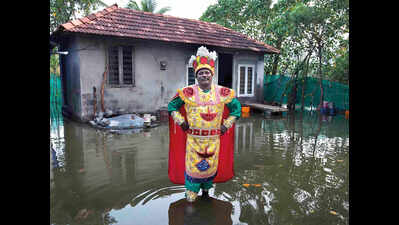ARTICLE AD BOX

The art was born on the island of Gothuruthu, 40km off Kochi, which was visited by 16th-century Portuguese missionaries. Initially, story arcs were inspired by biblical allegories
A photo exhibition in Goa celebrates Kerala’s Chavittunadakam — a compound of chavittu (‘to stamp’) and nadakam (‘drama’). This blend of movement and music is rooted in Portuguese legacy. Chavittunadakam not only relates epic tales but also displays the fisherfolk artists’ rhythmic grace under the pressure of climate change and societal indifference

The sea speaks in whispers and suddenly rouses its voice to a roar, but 63-year-old V A Thankachan stamps his feet on the earth with determination and devotion, respecting nature’s power to do what it wills.For nearly five decades, this artist from the fisherfolk community in Ernakulam has performed the Chavittunadakam.It is Kerala’s operatic form, in which the artists percuss the ground with their feet in entranced rhythms.Yet, even after years of embodying saints and soldiers, Thankachan’s voice now trembles with sorrow when he speaks of his place in the world.
Lofty art, lonely guardian
“Society never recognised me,” he says with a weary smile, his eyes not bitter but resigned.
“I gave my life to the art, but no one saw.”The art he guards like a sacred flame was born centuries ago on the island of Gothuruthu, 40km off Kochi, which was visited by 16th-century Portuguese missionaries. The stories told are biblical epics — David versus Goliath, the agony of sinners, and the rise and fall of monarchs.

But the men who breathe life into these legends, like Thankachan, return after each performance not to fanfare or accolades, but to leaky roofs and a shrinking coastline.
“After the 2004 tsunami, the tides began to betray the community. Once a protective barrier, the sea now creeps into our homes, especially during high tide,” said another artist. He was forced to abandon his home, uprooted by the very ocean that once inspired his rhythms.
Pics speak 1,000 paradoxes
Photographer K R Sunil has spent years documenting the life of Chavittunadakam artists after his visit to Chellanam, a narrow strip of coast south of Kochi, where he first witnessed the dance.
“They performed as if the sea was watching,” he said.On stage, the artists are kings in golden robes, but offstage, they return to jobs as daily-wage labourers and fishermen. Sunil’s lens has captured these paradoxes and put them on display at the Fundação Oriente Goa in Panaji, from July 17.This photo series was first exhibited in 2022 at Aazhi Archives at Mattanchery in Kochi, curated by Riyas Komu. Aazhi is both a digital and physical space to elucidate Kerala’s cultural highpoints. “With Chavittunadakam, people rise not only against the fading of their art, but also against the erosion of their land. Climate change now hits their homes and future,” Sunil said.

He said, “Families huddle together in small homes, their nights disrupted by the sound of water breaching their thresholds. Sleep becomes a luxury. They rest only after the storms pass, only after cleaning, drying and hoping that the water recedes.”
Humble artists, royals on stage
The youth drift away, lured by cities or numbed by indifference. Without institutional support or financial backing, Chavittunadakam teeters on the brink of oblivion. Yet in islands like Gothuruthu, where every house tells a story, each performance is a prayer.

When the artists step on the wooden stage, they become a mighty king, a daring queen, or even a prophet speaking to the wind. Their voice lifts with the chorus. “It is not fame that we seek, but remembrance. All I want is for people to know we were here, we danced, and we mattered.” Thankachan said.(The photo exhibition will be on display in Panaji till Aug 17)With inputs from Vishnu R




.png)
.png)
.png)
















 1 day ago
4
1 day ago
4








 English (US) ·
English (US) ·